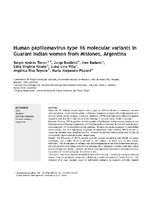Please use this identifier to cite or link to this item:
http://sgc.anlis.gob.ar/handle/123456789/425| DC Field | Value | Language |
|---|---|---|
| dc.contributor.author | Tonon, Sergio Andrés | - |
| dc.contributor.author | Basiletti, Jorge | - |
| dc.contributor.author | Badano, Inés | - |
| dc.contributor.author | Alonio, Lidia V. | - |
| dc.contributor.author | Villa, Luisa L. | - |
| dc.contributor.author | Teyssie, Angelica R. | - |
| dc.contributor.author | Picconi, María Alejandra | - |
| dc.date.accessioned | 2012-11-27T13:05:38Z | - |
| dc.date.available | 2012-11-27T13:05:38Z | - |
| dc.date.issued | 2007 | - |
| dc.identifier.issn | 1201-9712 | - |
| dc.identifier.uri | http://sgc.anlis.gob.ar/handle/123456789/425 | - |
| dc.identifier.uri | http://download.journals.elsevierhealth.com/pdfs/journals/1201-9712/PIIS1201971206000488.pdf | - |
| dc.description | Objective: To identify human papillomavirus type 16 (HPV16) E6 and L1 molecular variants infecting Guarani Indian women settled in Misiones, Argentina, a region with a high prevalence of cervical cancer. Some intratypic molecular variants of HPV16 have been associated with greater oncogenic risk, but their implication in the etiology of cervical cancer is still uncertain. Methods: Seventy HPV16 positive cervical samples from Guarani Indian women settled in two different areas of Misiones, Argentina, (34 from the northern area and 36 from the central area), were analyzed. Thirty-seven had normal cytology, 18 had a low-grade squamous intraepithelial lesion (LGSIL), and 15 a high-grade squamous intraepithelial lesion (HGSIL). HPV16 E6 and L1 molecular variants were identified by PCR, followed by dot blot hybridization with 23 and 12 biotinylated oligonucleotide probes, respectively. Results: The frequency of HPV16 variants over the Guarani population was 51% EP (European prototype), 32% E-350G, 9% Af1-a (African 1), 4% E-6862C, 3% Af2-a, and 1% AA-a (Asian-American). The distribution of variants was not homogeneous in the two areas under analysis, with the northern area being more diverse showing 74% of European variants, white the central area presented exclusively E variants. No statistically significant association was found between any particular variant and grade of cervical lesion. Conclusion: This study reports for the first time HPV16 E6 and L1 molecular variants infecting women from an aboriginal community inhabiting a rainforest region of South America. The presence of E class variants could be attributed primarily to contacts with the Spanish conquerors, and Af variants from African slaves introduced later in the South American continent. | ES |
| dc.description | Fil: Tonon, Sergio Andrés. Universidad Nacional de Misiones. Laboratorio de Biologia Molecular Aplicada; Argentina. | ES |
| dc.description | Fil: Basiletti, Jorge. ANLIS Dr.C.G.Malbrán. Instituto Nacional de Enfermedades Infecciosas. Servicio Virus Oncogénicos; Argentina. | ES |
| dc.description | Fil: Badano, Inés. Universidad Nacional de Misiones. Laboratorio de Biologia Molecular Aplicada; Argentina. | ES |
| dc.description | Fil: Alonio, Lidia Virginia. ANLIS Dr.C.G.Malbrán. Instituto Nacional de Enfermedades Infecciosas. Servicio Virus Oncogénicos; Argentina. | ES |
| dc.description | Fil: Villa, Luisa Lina. Ludwig Institute for Cancer Research. Virology Department; Brasil. | ES |
| dc.description | Fil: Teyssie, Angelica Rita. ANLIS Dr.C.G.Malbrán. Instituto Nacional de Enfermedades Infecciosas. Servicio Virus Oncogénicos; Argentina. | ES |
| dc.description | Fil: Picconi, María Alejandra. ANLIS Dr.C.G.Malbrán. Instituto Nacional de Enfermedades Infecciosas. Servicio Virus Oncogénicos; Argentina. | ES |
| dc.format | application/pdf | ES |
| dc.language.iso | eng | en_US |
| dc.rights | 2008-01-31 | en_US |
| dc.rights | info:eu-repo/semantics/embargoedAccess | en_US |
| dc.source | International Journal of Infectious Diseases, 2007, 11(1), 76-81. | en_US |
| dc.subject | Papillomavirus Humano 16 | en_US |
| dc.subject | Neoplasias del Cuello Uterino | en_US |
| dc.subject | Argentina | en_US |
| dc.subject | Misiones | en_US |
| dc.title | Human papillomavirus type 16 molecular variants in Guarani Indian women from Misiones, Argentina | en_US |
| dc.type | Artículo | es |
| dc.coverage | ARG | en_US |
| dc.coverage | Misiones | en_US |
| anlis.essnrd | 1 | es |
| item.fulltext | With Fulltext | - |
| item.languageiso639-1 | en | - |
| item.openairetype | Artículo | - |
| item.cerifentitytype | Publications | - |
| item.grantfulltext | open | - |
| item.openairecristype | http://purl.org/coar/resource_type/c_18cf | - |
| crisitem.author.dept | Administración Nacional de Laboratorios e Institutos de Salud “Dr. Carlos G. Malbrán” (ANLIS) | - |
| crisitem.author.dept | Instituto Nacional de Enfermedades Infecciosas (INEI) | - |
| crisitem.author.dept | Departamento de Virología | - |
| crisitem.author.dept | Servicio Virus Oncogénicos | - |
| crisitem.author.dept | Maestría en Microbiología Molecular UNSM-ANLIS | - |
| crisitem.author.dept | Administración Nacional de Laboratorios e Institutos de Salud “Dr. Carlos G. Malbrán” (ANLIS) | - |
| crisitem.author.dept | Instituto Nacional de Enfermedades Infecciosas (INEI) | - |
| crisitem.author.dept | Departamento de Virología | - |
| crisitem.author.dept | Servicio Virus Oncogénicos | - |
| crisitem.author.parentorg | Administración Nacional de Laboratorios e Institutos de Salud “Dr. Carlos G. Malbrán” (ANLIS) | - |
| crisitem.author.parentorg | Instituto Nacional de Enfermedades Infecciosas (INEI) | - |
| crisitem.author.parentorg | Departamento de Virología | - |
| crisitem.author.parentorg | Centro Nacional Red de Laboratorios (CNRL) | - |
| crisitem.author.parentorg | Administración Nacional de Laboratorios e Institutos de Salud “Dr. Carlos G. Malbrán” (ANLIS) | - |
| crisitem.author.parentorg | Instituto Nacional de Enfermedades Infecciosas (INEI) | - |
| crisitem.author.parentorg | Departamento de Virología | - |
| Appears in Collections: | snrd Publicaciones INEI | |
Files in This Item:
| File | Description | Size | Format | |
|---|---|---|---|---|
| InternationalJournal ofInfectiousDiseases,2007,11(1),76-81.pdf | 1.62 MB | Adobe PDF |  View/Open |
Page view(s)
161
checked on Dec 19, 2025
Download(s)
103
checked on Dec 19, 2025
Google ScholarTM
Check
Items in DSpace are protected by copyright, with all rights reserved, unless otherwise indicated.

